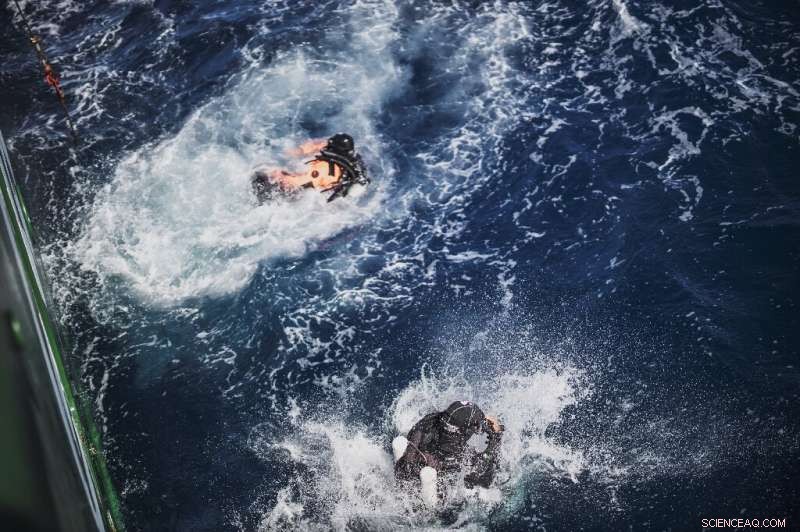
Un plus grand splash:les plongeurs commencent leur exploration du mont sous-marin Vema
Vêtus d'équipements de plongée ou de cirés et de bottes en caoutchouc, une équipe de scientifiques et d'activistes a passé des semaines dans l'Atlantique Sud, des tempêtes endurantes et une mer agitée pour vérifier un endroit dont presque personne n'a entendu parler.
Leur mission :surveiller une montagne sous-marine à la recherche d'indices de réchauffement climatique et de pollution plastique, et évaluer l'impact d'une interdiction de pêche au chalut vieille de 12 ans.
Les chercheurs de Greenpeace ont navigué à mille kilomètres (600 miles) au nord-ouest du Cap jusqu'au mont sous-marin de Vema, l'un des plus remarquables, encore méconnu, caractéristiques de la planète bleue.
La montagne volcanique s'élève un colossal 4, 600 mètres (15, 000 pieds) de l'abîme océanique - presque aussi haut que le Mont Blanc, le point culminant d'Europe.
Son sommet conique, érodé à un sommet plat par les vagues sur des milliers d'années, atteint à seulement 26 mètres (85 pieds) de la surface.
Des journalistes de l'AFP ont rejoint les 30 membres d'équipage, scientifiques et militants pendant 10 jours de leur longue exploration de trois semaines.
À bord du navire de recherche Arctic Sunrise, des plongeurs spécialisés ont partagé des blagues en enfilant des combinaisons étanches orange vif et noires, attaché sur des bouteilles d'air et a effectué les vérifications finales des caméras haute résolution.
Ils ont sauté par la porte pilote, disparaître dans les eaux d'un bleu profond pendant environ 45 minutes - un rituel deux fois par jour, le temps le permet.
Sous les vagues, les plongeurs ont prélevé des échantillons et enregistré un inventaire de la vie marine.
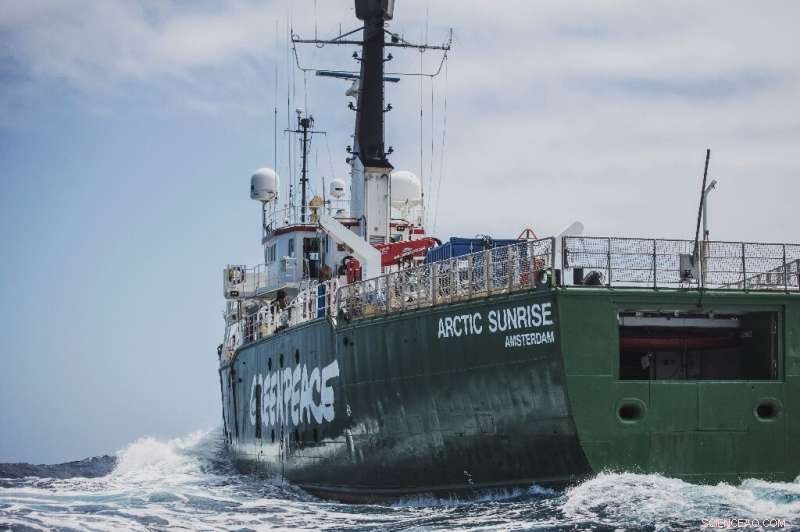
Le lever du soleil arctique, un brise-glace de construction norvégienne de 45 mètres (147 pieds)
Havre de l'océan
Vema est une oasis océanique - son sommet peu profond est baigné de soleil, permettre aux algues, varech et corail noir à pousser, qui à leur tour attirent poissons et crustacés.
Les plongeurs ont refait surface, exalté.
"Il y avait beaucoup de poissons autour de nous, juste nager autour de nous, dans un grand cercle. C'était absolument génial à voir. Magnifique ! », a déclaré le plongeur néerlandais Sander Jansson.
Vema, du nom d'un navire qui l'a découvert dans les années 1950, se trouve dans les eaux internationales.
Un peu plus d'un pour cent des zones océaniques situées en dehors des juridictions nationales bénéficient d'une forme de protection internationale, selon le site Internet Ocean Action de l'ONU.
Vema a la chance d'être l'une des rares zones des grands fonds à bénéficier d'un tel bouclier.
En 2007, un organisme intergouvernemental de science et de gestion des pêches, l'Organisation des pêches de l'Atlantique du Sud-Est (SEAFO) a interdit le chalutage de fond sur Vema et d'autres monts sous-marins.

Le biologiste marin Thilo Maack informe l'équipe de Greenpeace sur le mont sous-marin Vema. La zone semble se remettre de la surpêche, mais comme les mers partout est frappée par le réchauffement climatique
Certaines espèces de Vema ont clairement prospéré depuis lors.
"Il y a tellement de vie là-bas, ", a déclaré le biologiste marin et chef d'expédition Thilo Maack.
"Il y a des écrevisses, il y a beaucoup d'algues, il y a beaucoup d'éponges et de poissons de toutes sortes".
Il a ajouté:"C'est juste un exemple parfait de ce qui se passe si nous laissons la nature seule pendant une certaine période de temps même si elle a été surexploitée, il se reconstituera".
Les perspectives plus ensoleillées s'étendent même à la langouste de Tristan, une espèce qui a été deux fois presque en voie d'extinction pour répondre à la demande de fruits de mer en Asie de l'Est.
« Qui a dit qu'il n'y avait pas de homards là-bas ? » a plaisanté le plongeur allemand Pascal van Erp alors qu'il remontait sur le pont après sa première plongée.
When the current was too strong for divers to go into the water, the researchers launched an underwater drone and sat inside a blue shipping container on the ship's deck, monitoring screens sending back video footage.
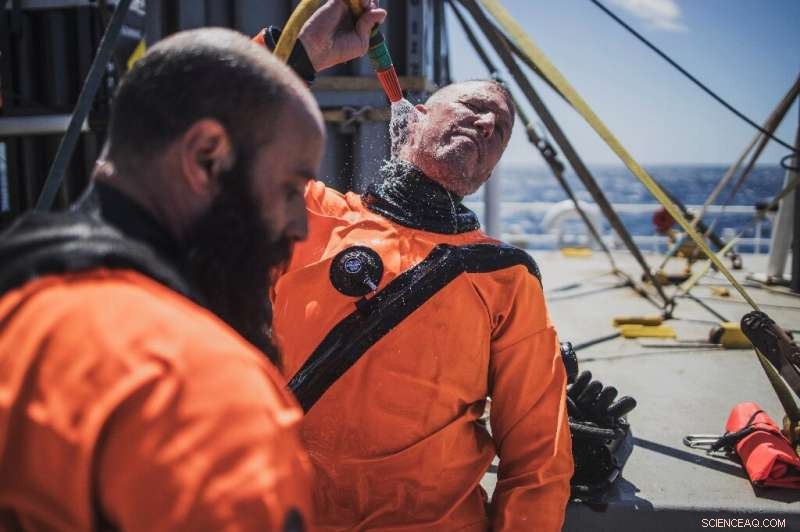
Divers rinse themselves with clean water after a dive to the seamount
Need for protection
Marine conservation organisations are pushing for ocean havens to be vastly expanded.
Greenpeace has mounted a pole-to-pole Arctic-to-Antarctic expedition to lobby the UN to come up with an international legally-binding treaty that protect at least 30 percent of the world's deep oceans from human activities and industrial fishing by 2030.
The UN is negotiating new policies and these which should be finalised at a global conference early next year.
Francois Engelbrecht, professor of climatology at South Africa's University of the Witswatersrand, said the plight of the oceans was like the fight against climate change—both had to be addressed at a planetary level.
"The entire Earth system is connected, it is a coupled system, and changes in one part of the world sooner or later affect many other parts of the world, " il a dit.
"So the international efforts to protect the oceans and to mitigate climate change are in fact an effort that requires tremendous international cooperation."
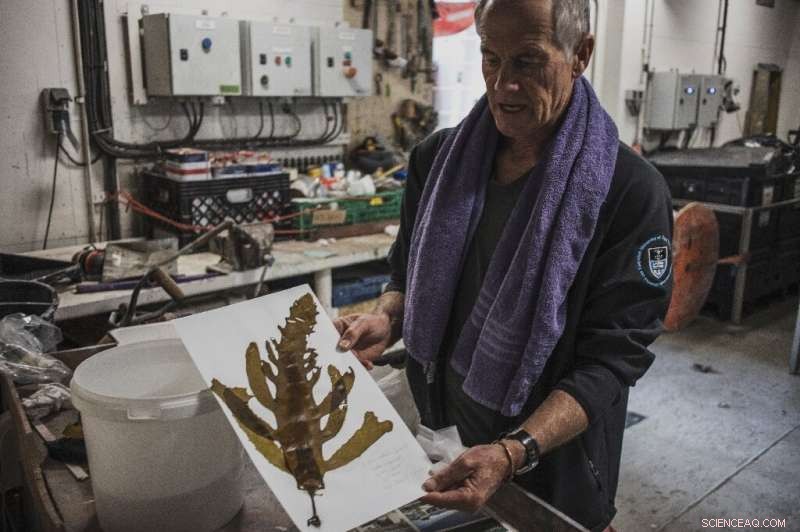
Marine biologist Robert Anderson prepares kelp samples for drying and analysis
Climate peril
The oceans play a vital role in the grim calculus of global warming.
They are, à la fois, a shield against warming, a future accelerator of it and a victim of it.
By absorbing a quarter of manmade carbon dioxide (CO2) and more than 90 percent of the heat generated by greenhouse gases, oceans avoid huge amounts of atmospheric warming, says the UN's top scientific panel, the Intergovernmental Panel for Climate Change (IPCC).
But warmer oceans means rising sea levels, as well as stored heat that will ultimately be released to the atmosphere—climate-altering mechanisms that may function for centuries to come.
"A breakdown in climate will ultimately impact on our oceans, " Bukelwa Nzimande, 29, a South African activist.
"They act as carbon sinks, they hold lots of wildlife which captures the carbon, at the same time they absorb excess heat that would ideally be felt by us as humanity."
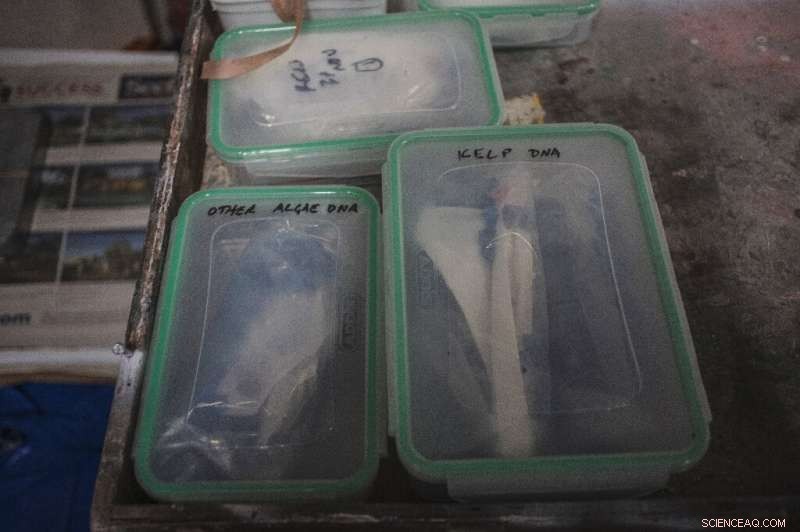
Samples are logged and stored for scrutiny in the lab
Higher sea temperatures and acidification caused by CO2 absorption are widely feared because of their impact on marine biodiversity, although this remains poorly understood.
One of the tasks at Vema was to look for evidence of whale migration and compare that with past years.
By comparing patterns of migration times, scientist hoped to make deductions over any changes to currents and feeding grounds.
Another priority was to look for discarded plastic, which is emerging as one of the biggest threats to marine wildlife.
Plastic bags can be swallowed by marine mammals, and small species absorb minute plastic particles that then accumulate up the food chain.
The UN estimates that 640, 000 tonnes of fishing equipment is discarded around the oceans each year.
Despite the general pristine state of Vema and the ban on fishing, there was evidence that fishing had taken place at Vema.
Divers found a lobster pot and video footage from a drone showed pieces of abandoned fishing nets, known as ghost gear.
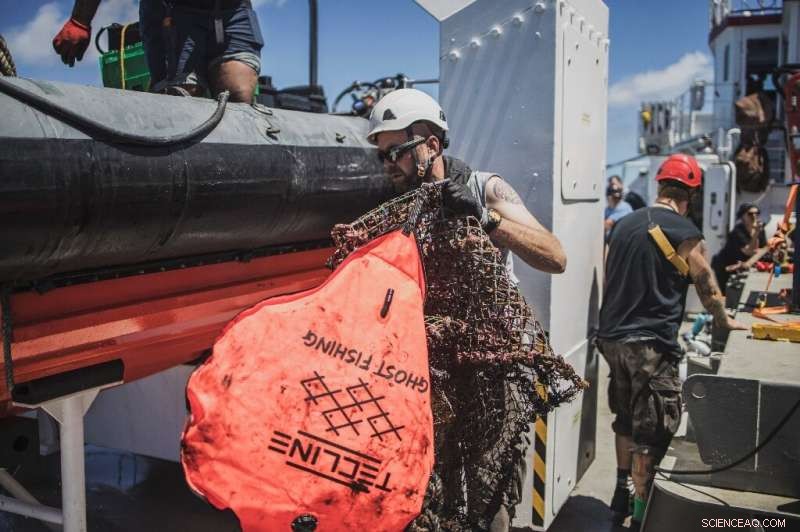
Ghost hunt:A Greenpeace crew member retrieves a device to identify abandoned nets and other fishing equipment. 'Ghost gear' is a major hazard for marine life
Life at sea
There were more than 30 crew, scientists and activists aboard the Arctic Sunrise, a 45-metre (147-feet) Norwegian-built ice breaker.
They hailed from South Africa, Allemagne, Netherlands, Belgium and Britain, among other nations.
They shared small cabins equiped with bunk beds, complete with guard rails for the stormy days when the ship swayed violently from side to side.
"Even if my employer today says there's no more money to pay me a salary, I will continue doing what I'm doing, " said deckhand Barry Joubert, 39, who quit his job at a game reserve in Parys, South Africa five years ago to join Greenpeace.
South African-born captain Mike Fincken, 55, spends six months of the year away from his seven-year-old son in Wales.
One of his deck assistants is Tuleka Zuma, a 31-year-old mother of an 18-month-old toddler back in South Africa's southeastern KwaZulu-Natal province.
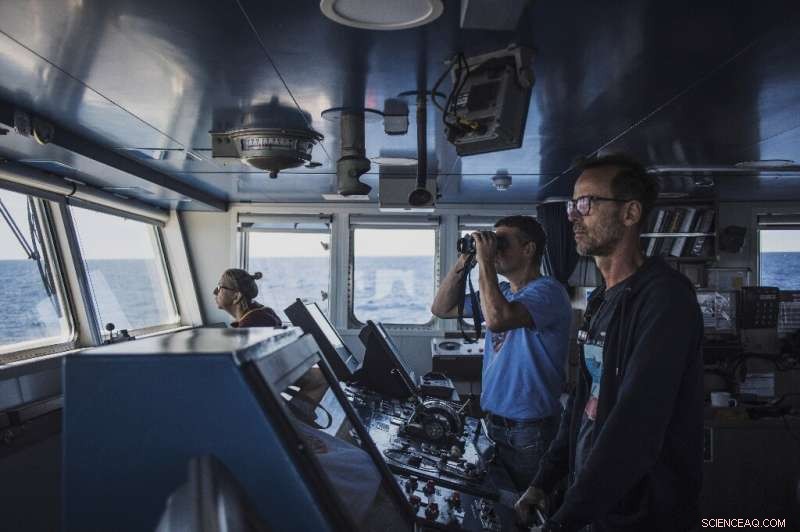
View from the bridge:Captain Mike Finchen, droit, and marine biologist Thilo Maack, looking through binoculars
Celine Desvachez, a 27-year-old Belgian boat pilot, said she cannot "find any meaningful way of living my life" other than doing what she did.
"Actually my personal battle is when I go off the ship, " elle a dit.
© 2019 AFP